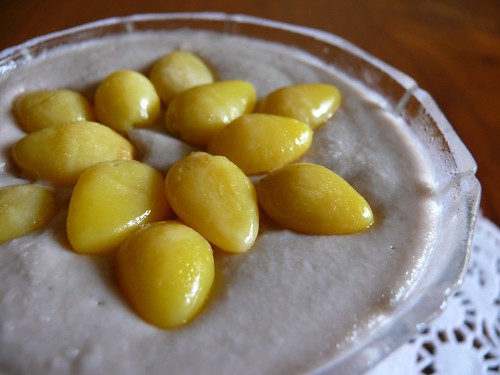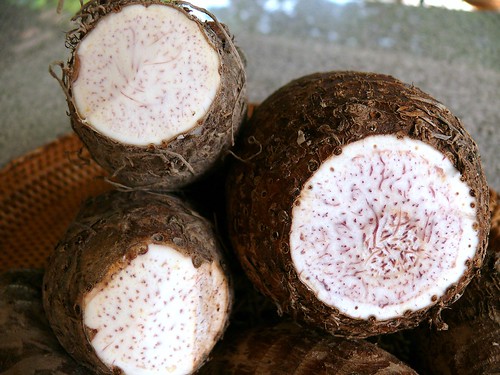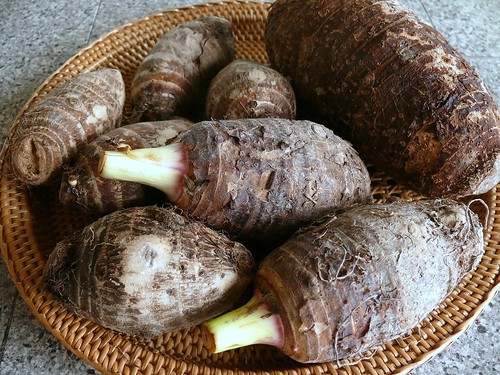
Orh nee, taro paste dessert
Just in case you are confused, taro is woo toe in Cantonese. In Malaysia and Singapore, the tuber is passed off as yam, causing a lot of confusion. I used to think yam and sweet potatoes are the same but apparently they aren't, and I've just realiZed I don't know what a yam looks like.
My son Wey recently declared that he loves taro over potatoes and other tubers because the flavor is so delightful. I have to agree with him. The flavor of taro is hard to describe: it's unique and a little bit floral. This tuber is yummy whether cooked in savory or sweet dishes. Getting a good taro is hard because instead of a floury taro, which is desirable, you may end up with a crunchy taro, which is terrible because it not only means the flavor is low, but also means it will not mash or break up into powdery crumbs. Imagine a potato that is crunchy like an apple. Vendors will willingly slice off one end of the taro to show you the specks and veins, and they'll show you their knife. If the knife that they just cut the taro with has a whitish sap, it indicates a floury taro. If you draw a finger across the cut surface of the taro and rub your fingers and it feels floury/powdery, the taro's going to be very floury. My way of checking if a taro is floury is by the looks--if there are lots of purple specks and veins, the taro is likely to be floury. As a rule, I find that the bigger and older the taro, the more likely it is to be floury.

The taro on the right is floury--it has lots of purple veins indicating that it's mature. The two smaller taro couldn't be mashed--they were crunchy.

Those small taro are from China. Boiled in salted water and eaten as a snack, their texture can vary between crunchy and floury and in between but their taro flavor is great.
Taro is a hardy plant that grows everywhere, by the roadside, near the ponds and the drains especially in the countryside. You can recognize them by their large heart-shaped leaves but you may be deceived by the wild taro which looks very similar but has a green stem instead of brown. Do be careful when you peel a taro because the sap will make your hands itchy so it's a good idea to wear a pair of gloves or wash immediately after peeling.
This dessert came about by default. I made wu gok (taro puffs) for the 5th time, and again the result was gok that didn't puff: they were like croquettes and brown potatoes, heavy and dense. I have no choice but to add ammonia the next time I try making wu gok.
So there I was, with a plateful of taro mash. I was too fed-up to make another batch of woo gok. Orh nee came to mind. I made orh nee once, a long time ago and the result killed my craving for it. The old-fashioned recipe called for pork fat, lots of sugar, chunks of pumpkin but it wasn't the fat or sugar that put me off. The authentic orh nee is a very thick paste. It sticks to your throat as you swallow, like cement I imagine. The new version of orh nee is lighter, very smooth and IMHO, much more delicious than the authentic version.
This orh nee is similar to those sold in food courts in Singapore. Since I love santan (coconut milk), that's what I used. I don't think milk makes a good substitute, neither will canned or powder santan. I've replaced the lard with a little bit of veg oil (Canola) so the orh nee isn't very very smooth but you can add more oil if that's important to you. If you have a better recipe that results in very smooth orh nee without the addition of too much oil, please let me know.

Orh Nee (6-8 servings)
600g mashed taro*
3/4 to 1 cup fine sugar
3/4 cup water
250 ml thick coconut milk (the thicker the better)
3 T veg oil (or more, if like)
1/3 to 1/2 cup shelled gingko nuts (remove the 'heart' if like)
* This is the weight after peeling. Peel and cut the taro into small chunks, steam about 20 minutes and mash when still hot.
1. Put the sugar, water and gingko nuts into a small pot and boil until the sugar has dissolved. The gingko nuts will be sweet and chewy. If you prefer not to sweeten the gingko nuts, you can boil them separately or just boil the nuts briefly in the sugar.
2. Put the mashed taro and coconut milk into a blender, add the sugar syrup and blend until very fine.
3. Pass the thick mash through a fine sieve into a small pot, using a large spoon to scrape and drive the mash through. This will take a bit of work but will ensure a smooth paste.
4. Put the pot of mash over a small fire, stirring all the time. Add the oil (amount to your liking), stir and cook for about 10 minutes to develop the flavor and thicken the paste. If you prefer a thinner paste, add more santan or water.
5. If the paste is very thick, arrange the cooked gingko nuts in a deep bowl, carefully scoop the paste on top. Level and let cool. Chill in the fridge and turn the bowl of paste onto a plate to serve. If paste is thinner, it can't firm up so you can't turn it over. Just pour the paste into a serving glass. When paste has cooled, arrange the cooked gingko nuts on top. Serve cold.

11 comments:
Oh, I miss this a lot !! Terri, this is supposed to be eaten warm, not cool leh & the 'heart' in gingko nut has to be removed before eating, it's poisonous, isn't it ??
Hey, Terri. Interesting posts. Been out of it for awhile since computer died. But new one and back on. Good reads.
This dish is to be eaten warm by the Teochew clan. Your method of making orr nee is different. It's not the oil that makes the orr nee smooth, it's the blending. If you happens to visit Penang, do drop by a Teochew restaurant in Gurney Drive for their orr nee.
This is my favourite dish. Agree with Lorrine, it should be eaten warm. Teochews use lard to fry shallots then add it to make the paste. Tradtionally, it will be accompanied with pumpkin. Coconut milk and gingko nuts are not used. I haven't tried with Thailand yam yet but friends said it will yield a smoother texture.
ganache: oh oh. u a teochew nang? is it eaten warm? i eat it cold bc of the santan lol. about the gingko nuts, i've never known of ppl getting poisoned eating it. my mom always remove the plumule or 'heart' bc it's bitter but in the process of removing the nut comes apart. my MIL doesn't remove the plumule at all n i'm used to tt
tealady: i read tt, n i know how computer withdrawal symtoms feel! my comp is still not running very well. so frustrating.
anon:i guess the authentic version has to be eaten warm bc of the lard? the new version with santan is better cold i think, but then i'm not a teochew, so thanx for telling me:)
rei: ok ok i hear u all :D : orh nee is eaten warm. but rei, when in sing, the version i ate is lighter n had gingko (see my link on the post) n it def didn't hav any pork oil or shallots. please enlighten me on this!
Hi Terri, yes, the version these days are lighter and hardly use lard anymore. Mainly due to health concerns and some cater to Muslim crowd as well. Using shallots add flavour to the dessert. I will give a rough idea how Teochews do this but I do not have the proportions. Granny and mom cook by feel and I have yet to master it.
1. Cut pumpkin in chunks and cover with sugar (lots). Leave in the fridge overnight.
2. Steam and mash yam through a sieve.
3. Fry shallots with lard till turning crisp. Remove shallots. Low heat, fry mashed yam with sugar, stir constantly till paste-like. Do not let it caramelise.
4. Cook pumpkin with the sugar with low heat till soft. Serve together with yam paste. The pumpkin will add moisture to the yam paste.
Btw, I spotted a bottle of sauce for cooking 'water cooked fish'. Think it's possible to mail it to you?
The orh nee I had in JB also used fried shallots and the oil used to fry it as a flavouring. Twas soo good. =]
ya I m about to ask if this can be eaten warm? I feel Santan should be in Warm way! lolz! Can U tell me why you eat cold bcuz of "santan" here?
* I am longing for a carrot cake recipe from u, i m not sure if u're willing to share? hahaha, u can't bring all recipes with u lolz*
I'm hokkien nang ! Oh btw thanks for your tips on choosing yam, now I know :)
just curious - have you ever had poi?
Hi am new to your blog but am really thankful for your tips on choosing yam :D
Will try orh nee with onion oil. Hope it works out well :D
Post a Comment